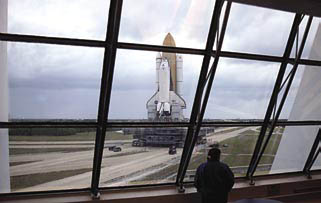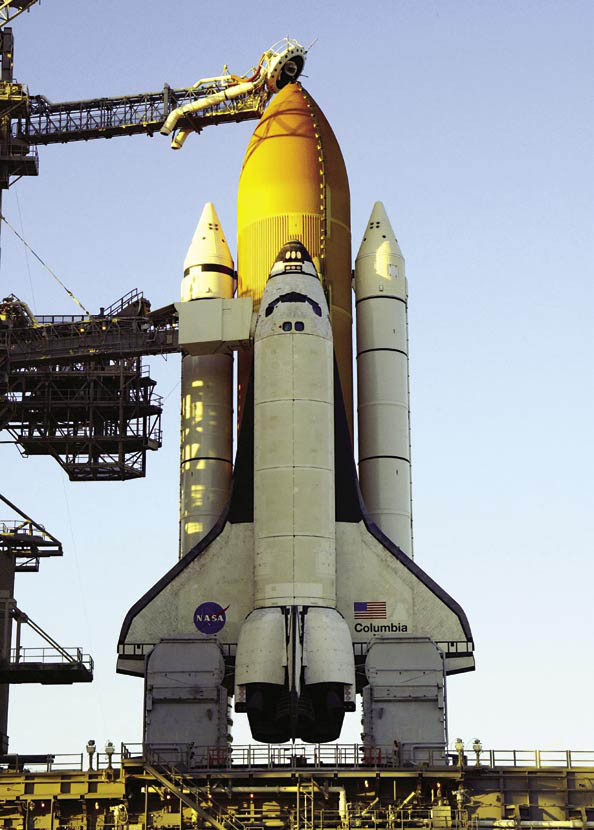EXECUTIVE SUMMARY
The Columbia Accident Investigation Boards independent investigation into the February 1, 2003, loss of the Space Shuttle Columbia and its seven-member crew lasted nearly seven months. A staff of more than 120, along with some 400 NASA engineers, supported the Boards 13 members. Investigators examined more than 30,000 documents, conducted more than 200 formal interviews, heard testimony from dozens of expert witnesses, and reviewed more than 3,000 inputs from the general public. In addition, more than 25,000 searchers combed vast stretches of the Western United States to retrieve the spacecrafts debris. In the process, Columbias tragedy was compounded when two debris searchers with the U.S. Forest Service perished in a helicopter accident.
2003年2月1日に起きたスペースシャトルコロンビアとその乗員が失われた事故について、コロンビア事故調査委員会(The Columbia Accident Investigation Board:CAIB)は7ヶ月に渡る独立した調査を行いました。スタッフは120人を越え、13人の委員会メンバーを支援するエンジニアは400人に達しました。調査員たちは、30,000もの文書を調査し、200人へのインタビューを行い、数多くの専門家の意見を聞き、3,000以上の目撃証言を検討しました。さらに、25,000人の調査員がアメリカ西部で行われた宇宙船の破片調査を行いました。その過程で、ヘリコプターの墜落事故によりU.S. Forest Serviceの2人の調査員が命を落とし、この「コロンビアの悲劇」に、さらに2人の名前が加わることになりました。
The Board recognized early on that the accident was prob-ably not an anomalous, random event, but rather likely root-ed to some degree in NASAs history and the human space flight programs culture. Accordingly, the Board broadened its mandate at the outset to include an investigation of a wide range of historical and organizational issues, including polit-ical and budgetary considerations, compromises, and chang-ing priorities over the life of the Space Shuttle Program. The Boards conviction regarding the importance of these factors strengthened as the investigation progressed, with the result that this report, in its findings, conclusions, and recommen-dations, places as much weight on these causal factors as on the more easily understood and corrected physical cause of the accident.
調査委員会は、早い段階でこの事故が変則的かつ偶発的な出来事ではなく、NASAの歴史と有人宇宙飛行計画の文化に根ざしていると考え、調査の枠を歴史的、組織的な問題に広げました。ここには、政治的・予算的な検討と妥協案、シャトルプログラムの命運に関する優先順位の変更などが含まれています。シャトルの委員会のメンバーは、調査が進むにつれ、これらの問題の重要性を確信しました。このレポートの調査結果や結論、勧告では、より簡単に理解でき対処可能な事故の物理的な原因と同じくらい、これらの歴史的、組織的な問題に重きが置かれています。
The physical cause of the loss of Columbia and its crew was a breach in the Thermal Protection System on the leading edge of the left wing, caused by a piece of insulating foam which separated from the left bipod ramp section of the External Tank at 81.7 seconds after launch, and struck the wing in the vicinity of the lower half of Reinforced Carbon-Carbon panel number 8. During re-entry this breach in the Thermal Protection System allowed superheated air to pen-etrate through the leading edge insulation and progressively melt the aluminum structure of the left wing, resulting in a weakening of the structure until increasing aerodynamic forces caused loss of control, failure of the wing, and break-up of the Orbiter. This breakup occurred in a flight regime in which, given the current design of the Orbiter, there was no possibility for the crew to survive.
コロンビアと、そのクルーが失われた物理的な原因は、打上げの81.7秒後に外部燃料タンクの左バイポット部から脱落した断熱材の破片の衝突によって、左翼前縁部の耐熱システムに亀裂が生じたためだと考えられます。衝突は強化カーボン-カーボンパネル(RCCパネル)の8番の下面付近です。この耐熱システムの亀裂から、再突入の際の超高温の空気が翼前縁部へ侵入し、徐々に左翼のアルミの構造材を溶かしていきました。空力的な抵抗が増していく中で、この弱くなった構造材は、操縦不能と主翼の欠落、そして空中分解を引き起こしたのです。この状況、現状のデザインのオービターでは、クルーが生き残る可能性はありませんでした。
The organizational causes of this accident are rooted in the Space Shuttle Programs history and culture, including the original compromises that were required to gain approval for the Shuttle, subsequent years of resource constraints, fluc-tuating priorities, schedule pressures, mischaracterization of the Shuttle as operational rather than developmental, and lack of an agreed national vision for human space flight. Cultural traits and organizational practices detrimental to safety were allowed to develop, including: reliance on past success as a substitute for sound engineering practices (such as testing to understand why systems were not performing in accordance with requirements); organizational barriers that prevented effective communication of critical safety information and stifled professional differences of opinion; lack of integrated management across program elements; and the evolution of an informal chain of command and decision-making pro-cesses that operated outside the organizations rules.
この事故の組織的な原因は、スペースシャトルプログラムの歴史と文化に根ざしています。それは、シャトル計画が承認を得るためになされた最初期での妥協や、その後に強いられたリソースへの圧迫、ころころ変わる優先権、スケジュールのプレッシャー、実験機というより実用機として使用されたシャトルの位置付けへの誤解、そして有人宇宙飛行に対する国家的なビジョンと同意の欠如、などです。また、安全の確保に対して害をなす文化的な性格と組織的な慣習は放置され、はびこるに任されていました。信頼に足る工学―たとえば、なぜシステムが要求されたような性能を発揮しないかを調査するテストなど―を実践する代わりに過去の成功体験に頼ったり、安全に関する重要な情報のやりとりを阻害する組織的な壁や専門分野の違いからくる意見の食い違いが起きていたり、プログラムのそれぞれの要素を包含する統合されたマネージメントが欠如していたり、非公式の命令系統や意思決定プロセスなどが組織のルールの外で運用されていたり、といった具合です。
This report discusses the attributes of an organization that could more safely and reliably operate the inherently risky Space Shuttle, but does not provide a detailed organizational prescription. Among those attributes are: a robust and in-dependent program technical authority that has complete control over specifications and requirements, and waivers to them; an independent safety assurance organization with line authority over all levels of safety oversight; and an or-ganizational culture that reflects the best characteristics of a learning organization.
この報告書は、本質的にリスクの高いスペースシャトルを運用するに足る信頼性と安全性を確保できる組織のあり方について議論します。ただし、細かい組織規定を提供するものではありません。これらの「組織あり方」には、以下のようなものを含みます。要求と仕様を完全にコントロールする強固で独立した技術的なオーソリティの設置と彼らへの権利委譲。安全に関する独立した保障機関の設置、「学習する組織」の性格を持った組織文化などです。
This report concludes with recommendations, some of which are specifically identified and prefaced as "before return to flight." These recommendations are largely related to the physical cause of the accident, and include prevent-ing the loss of foam, improved imaging of the Space Shuttle stack from liftoff through separation of the External Tank, and on-orbit inspection and repair of the Thermal Protec-tion System. The remaining recommendations, for the most part, stem from the Boards findings on organizational cause factors. While they are not "before return to flight" recommendations, they can be viewed as "continuing to fly" recommendations, as they capture the Boards thinking on what changes are necessary to operate the Shuttle and future spacecraft safely in the mid- to long-term.
この報告書の最後の部分では、『勧告』がなされています。あるものは「飛行に戻る前に」と題されたもので、事故の物理的な側面に大きく関係しています。ここに含まれるのは、断熱材の落下を防ぐこと、打上げから外部燃料タンクの切り離しまでのスペースシャトルの映像の品質を向上させること、軌道上での耐熱システムの検査と修理を可能にすることなどに関するものです。それ以外は、ほとんどが委員会が発見した組織的な問題点を中心とするものです。これらは「飛行に戻る前に」行うべきものではありませんが、「飛行を続けていくために」必要とされるもので、シャトルや次世代機を中長期的に安全に運用するために必要と考えられるものが挙げられています。
These recommendations reflect both the Boards strong support for return to flight at the earliest date consistent with the overriding objective of safety, and the Boards conviction that operation of the Space Shuttle, and all human space-flight, is a developmental activity with high inherent risks.
これらの勧告は、全てに優先されるべき「安全」という目的と矛盾せずに最短の日数で飛行に戻ることへの委員会メンバーの強い支持と、シャトルやその他の有人宇宙飛行の運用は本質的に高いリスクを持っているという確信の両方を反映しています。

A view from inside the Launch Control Center as Columbia rolls out to Launch Complex 39-A on December 9, 2002
2002年12月9日、打上げ管制センターから見た、39-A発射台に向けてロールアウトするコロンビア。

Columbia sit on Launchi Complex 39-A prior to STS-107
STS-107の前に、39-A発射台の上のコロンビア